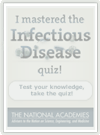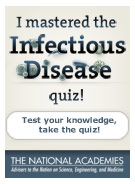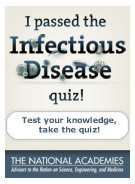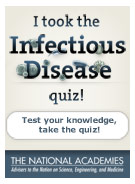
What You Need To Know About Infectious Disease
What do you know about infectious disease?
True or False: Not all microbes are harmful to humans.
-
Correct!
Not all microbes are harmful to humans. In fact, many of them protect us, helping our bodies function properly and competing with harmful organisms in an eternal contest for habitable space in or on our bodies. Although the microorganisms that cause disease often receive more attention, most microorganisms do not cause illness.
-
Sorry, that’s incorrect.
Not all microbes are harmful to humans. In fact, many of them protect us, helping our bodies function properly and competing with harmful organisms in an eternal contest for habitable space in or on our bodies. Although the microorganisms that cause disease often receive more attention, most microorganisms do not cause illness.
For each child who dies from pneumonia in an industrialized country, about how many children die from the infection in developing countries?
-
Sorry, that’s incorrect.
Life-saving vaccines and medications aren’t distributed equitably around the world; for each child who dies from pneumonia in an industrialized country, more than 2,000 children die from the infection in developing countries.
-
Sorry, that’s incorrect.
Life-saving vaccines and medications aren’t distributed equitably around the world; for each child who dies from pneumonia in an industrialized country, more than 2,000 children die from the infection in developing countries.
-
Sorry, that’s incorrect.
Life-saving vaccines and medications aren’t distributed equitably around the world; for each child who dies from pneumonia in an industrialized country, more than 2,000 children die from the infection in developing countries.
-
Correct!
Life-saving vaccines and medications aren’t distributed equitably around the world; for each child who dies from pneumonia in an industrialized country, more than 2,000 children die from the infection in developing countries.
Which are examples of ways that pathogens (disease-causing microbes) can spread?
- Coughing
- Eating undercooked pork
- Flea bite
- Breathing dust particles containing microorganisms
- All of the above
-
Sorry, that’s incorrect.
All are examples of ways that pathogens can spread. Coughing is an example of airborne droplet transmission; eating undercooked pork is an example of common vehicle transmission; a flea bite is an example of vector transmission; and breathing contaminated dust particles is an example of airborne transmission.
-
Sorry, that’s incorrect.
All are examples of ways that pathogens can spread. Coughing is an example of airborne droplet transmission; eating undercooked pork is an example of common vehicle transmission; a flea bite is an example of vector transmission; and breathing contaminated dust particles is an example of airborne transmission.
-
Sorry, that’s incorrect.
All are examples of ways that pathogens can spread. Coughing is an example of airborne droplet transmission; eating undercooked pork is an example of common vehicle transmission; a flea bite is an example of vector transmission; and breathing contaminated dust particles is an example of airborne transmission.
-
Sorry, that’s incorrect.
All are examples of ways that pathogens can spread. Coughing is an example of airborne droplet transmission; eating undercooked pork is an example of common vehicle transmission; a flea bite is an example of vector transmission; and breathing contaminated dust particles is an example of airborne transmission.
-
Correct!
All are examples of ways that pathogens can spread. Coughing is an example of airborne droplet transmission; eating undercooked pork is an example of common vehicle transmission; a flea bite is an example of vector transmission; and breathing contaminated dust particles is an example of airborne transmission.
True or False: Thimerosal, a mercury-containing preservative that was used in some vaccines and other products, has been shown to present a risk to human health.
-
Sorry, that’s incorrect.
The use of thimerosal has been an object of controversy, with some arguing that the substance caused autism in children. However, extensive independent research has presented no convincing evidence of harm associated with the low levels of thimerosal previously present in vaccines.
-
Correct!
The use of thimerosal has been an object of controversy, with some arguing that the substance caused autism in children. However, extensive independent research has presented no convincing evidence of harm associated with the low levels of thimerosal previously present in vaccines.
Which of the following is NOT a type of infectious agent?
-
Sorry, that’s incorrect.
White blood cells are not a type of infectious agent. Part of the immune system, white blood cells fight infection rather than cause it.
-
Sorry, that’s incorrect.
White blood cells are not a type of infectious agent. Part of the immune system, white blood cells fight infection rather than cause it.
-
Correct!
White blood cells are not a type of infectious agent. Part of the immune system, white blood cells fight infection rather than cause it.
-
Sorry, that’s incorrect.
White blood cells are not a type of infectious agent. Part of the immune system, white blood cells fight infection rather than cause it.
True or False: Scientists predict that rising average temperatures in some regions will change the transmission dynamics and geographic range of cholera, malaria, dengue fever, and tick-borne diseases.
-
Correct!
Scientists predict that rising average temperatures in some regions—a result of climate change—will change the transmission dynamics and geographic range of cholera, malaria, dengue fever, and tick-borne diseases.
-
Sorry, that’s incorrect.
Scientists predict that rising average temperatures in some regions—a result of climate change—will change the transmission dynamics and geographic range of cholera, malaria, dengue fever, and tick-borne diseases.
Which of the following is needed to help improve the public health situation in developing countries?
- More safe water supplies
- Better sewage treatment and disposal
- Improved food safety and vaccination programs
- All of the above
-
Sorry, that’s incorrect.
All of the above are urgently needed in developing nations. A major barrier to achieving these improvements is the underlying weakness of health systems in resource-poor countries, including a shortage of health workers and a lack of disease surveillance programs.
-
Sorry, that’s incorrect.
All of the above are urgently needed in developing nations. A major barrier to achieving these improvements is the underlying weakness of health systems in resource-poor countries, including a shortage of health workers and a lack of disease surveillance programs.
-
Sorry, that’s incorrect.
All of the above are urgently needed in developing nations. A major barrier to achieving these improvements is the underlying weakness of health systems in resource-poor countries, including a shortage of health workers and a lack of disease surveillance programs.
-
Correct!
All of the above are urgently needed in developing nations. A major barrier to achieving these improvements is the underlying weakness of health systems in resource-poor countries, including a shortage of health workers and a lack of disease surveillance programs.
Where do microbes live?
-
Sorry, that’s incorrect.
Microbes live in all of these places. They also live in plants and in the air. They can even survive in extreme environments like hot springs, deep ocean thermal vents, and polar ice.
-
Sorry, that’s incorrect.
Microbes live in all of these places. They also live in plants and in the air. They can even survive in extreme environments like hot springs, deep ocean thermal vents, and polar ice.
-
Sorry, that’s incorrect.
Microbes live in all of these places. They also live in plants and in the air. They can even survive in extreme environments like hot springs, deep ocean thermal vents, and polar ice.
-
Sorry, that’s incorrect.
Microbes live in all of these places. They also live in plants and in the air. They can even survive in extreme environments like hot springs, deep ocean thermal vents, and polar ice.
-
Correct!
Microbes live in all of these places. They also live in plants and in the air. They can even survive in extreme environments like hot springs, deep ocean thermal vents, and polar ice.
The human papillomavirus (HPV) causes about what percentage of cervical cancer cases?
-
Sorry, that’s incorrect.
The human papillomavirus (HPV) causes more than 90% of cervical cancer cases.
-
Sorry, that’s incorrect.
The human papillomavirus (HPV) causes more than 90% of cervical cancer cases.
-
Correct!
The human papillomavirus (HPV) causes more than 90% of cervical cancer cases.
Thank you for taking our quiz.
Place this badge on your Facebook page to show your friends what you know about infectious disease.
Place this badge on your Facebook page to show your friends what you know about infectious disease.
OR, get a higher score to unlock a different badge.

Place this badge on your Facebook page to show your friends what you know about infectious disease.
OR, get a higher score to unlock a different badge.

Explore Other Topics
Disease Watchlist
Infectious Disease Defined
- Bioweapon
A bacterium, virus, or other biological toxin used in bioterrorism or biological warfare.


